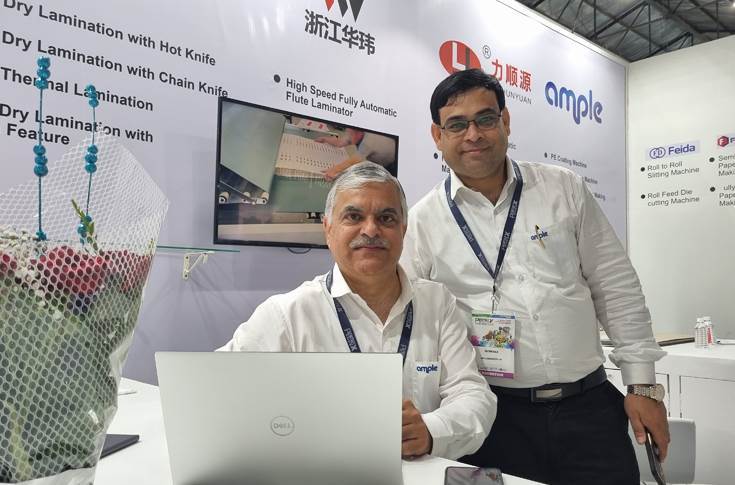Pamex 2023: Ample focuses on automation
Flat organisations are possible and can be a reality, says Rajeev Jagga of Ample Graphics, in an interview with Rahul Kumar, as the company showcases improved versions of their flagship products at Pamex 2023.
28 Mar 2023 | By Rahul Kumar
Rahul Kumar (RK): Can you share an update on the latest that you will be showing at Pamex 2023?
Rajeev Jagga (RJ): We are demonstrating two machines at Pamex 2023 — the film lamination machine and the high-speed corrugated flute laminator.
The film lamination machine is our flagship product, which has over 50 installations in India. The unique feature of the new model, KFM-106MCZ, is that it has a special delam unit. This feature is designed keeping in mind the sustainable packing goals, where the print buyer wants to eliminate the use of plastic while continuing to provide the metalised effect for his packages with the use of a special type of metalised film which has transfer properties. During the lamination process, the metal particles are transferred onto paper and the film is removed in the delam unit.
The high-speed corrugated flute laminator is an improved version of the machine showcased in PrintPack 2022. The speed is the same but paper handling has been improved, thereby reducing wastage and increasing the pasting accuracy.
RK: What are your sales numbers in the last 12 months (March 2022 to March 2023)?
RJ: We are pleased to say that we met our 2022-23 revenue targets in February itself. We are excited about 2023-24 after the V-shaped recovery post-Covid. Indian printers have made huge investments in the last year and we see the trend continuing into the next year as well.
RK: A little ahead, we have the big show — Interpack, Labelexpo Europe 2023, Drupa 2024. Would your company be part of these shows?
RJ: As you know, Ample Graphics is one of the pioneers in introducing affordable automation and reliable packaging machines from China. Our range has grown over the last five-six years, but there was a break during the Covid years. This year, we have added food packaging to our portfolio. Most of our principal companies are present in Drupa 2024. So, we expect them to announce new developments there. We will keep our customers updated about these developments.
RK: During our interaction with packaging companies, it is observed that run lengths have shrunk and capacities to have multi-product portfolios with quick changes are desired. Lower inventories have or will become the norm. Do these sentiments reflect in your interaction with the packagers? Does it reflect in your sales numbers?
RJ: We have supported automation from day one. One of the most important changes we have seen post-Covid is that customers today do not equate the cost of automatic machines with labour reduction. Now, converters value consistent quality, higher throughput and better yields. Premium is paid for quick changeover, fewer operators and high MTBF. The sales figures do not exactly show this but the value of the machines definitely demonstrates it. Machines with more features are now easy sell, thereby increasing the sale value.

RK: Most of the CEO’s energy is focused on taxes. How does one try to find one focused on the business?
RJ: With the introduction of GST, I think the focus on taxes has diminished, but now the new incentive schemes like PLI and subsidies on loans, etc have brought the focus back to tax saving as a guideline for investment. Even though this can change numbers, exclusive focus on this does not form the core of investment strategy.
RK: Most print-packaging companies PrintWeek/WhatPackaging? meet, and talk about growth but also say it’s essential to keep the machines running with wafer-thin or no-margin jobs. Isn’t it a risky strategy – a low profit margin leaves little room for error and may struggle to sustain itself if it encounters unexpected challenges or market downturns?
RJ: It could have been a strategy during the covid years, but I don’t see any packaging customers working on this format anymore. Most of our customers either made new investments last year or are planning expansion in the next couple of years. Investments cannot come with this wafer-thin margin strategy.
RK: The number of levels in a factory almost always directly correlates to more bottlenecks. One simple step that everyone should follow in their factory that can benefit our audience?
RJ: Again, automation is the key. Now, we also provide statistical data and monitoring instrumentation and related software through our sister concern for a direct interpretation and MIS to senior management, thereby eliminating the need for a hierarchical structure. Flat organisations are possible and can be a reality.
RK: Recently, a few print companies informed us that there’s a spike in the cost of spares. An upward revision of service rates followed this. It’s become a cause for concern. How would you explain these hikes as a print/print converting equipment/ software supplier?
RJ: Please understand that the last three years have seen an exponential increase in material costs. Equipment suppliers have to pass on this cost to their customers. Without pointing fingers, a sustained growth market also makes it easier for manufacturers to increase prices. This is what we are seeing, along with material cost increases.
RK: Sustainability initiatives are on the rise. How do the technologies and manufacturing you deploy come closer to meeting lofty sustainability goals?
RJ: We have increased our focus on providing solutions to our customers with sustainability in mind.
RK: How is your company better placed than its competitors?
RJ: To have survived the tumultuous Covid years puts one ahead. And witnessing the V-shaped recovery of last year has put the wind beneath our wings. We are financially healthier and have taken on some of the manpower that became available during those critical times.












 See All
See All